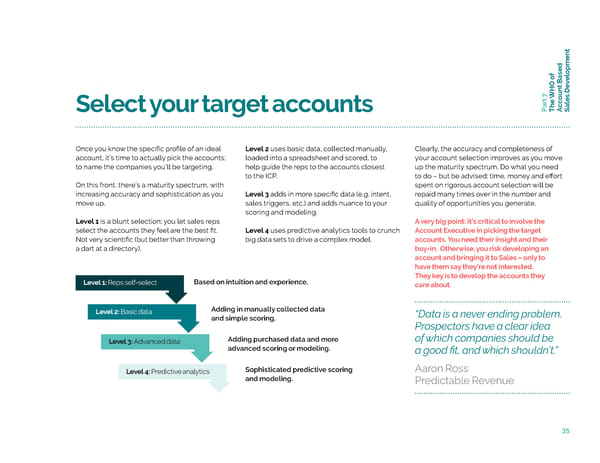t f o elopmen t Based v oun c art 7c Select your target accounts P The WHO ASales De Once you know the specific profile of an ideal Level 2 uses basic data, collected manually, Clearly, the accuracy and completeness of account, it’s time to actually pick the accounts; loaded into a spreadsheet and scored, to your account selection improves as you move to name the companies you’ll be targeting. help guide the reps to the accounts closest up the maturity spectrum. Do what you need to the ICP. to do – but be advised: time, money and effort On this front, there’s a maturity spectrum, with spent on rigorous account selection will be increasing accuracy and sophistication as you Level 3 adds in more specific data (e.g. intent, repaid many times over in the number and move up. sales triggers, etc.) and adds nuance to your quality of opportunities you generate. scoring and modeling. Level 1 is a blunt selection: you let sales reps A very big point: it’s critical to involve the select the accounts they feel are the best fit. Level 4 uses predictive analytics tools to crunch Account Executive in picking the target Not very scientific (but better than throwing big data sets to drive a complex model. accounts. You need their insight and their a dart at a directory). buy-in. Otherwise, you risk developing an account and bringing it to Sales – only to have them say they’re not interested. They key is to develop the accounts they Level 1: Reps self-select Based on intuition and experience. care about. Level 2: Basic data Adding in manually collected data “Data is a never ending problem. and simple scoring. Prospectors have a clear idea Level 3: Advanced data Adding purchased data and more of which companies should be advanced scoring or modeling. a good fit, and which shouldn’t.” Level 4: Predictive analytics Sophisticated predictive scoring Aaron Ross and modeling. Predictable Revenue 35
 The Clear & Complete Guide to ABS Page 34 Page 36
The Clear & Complete Guide to ABS Page 34 Page 36